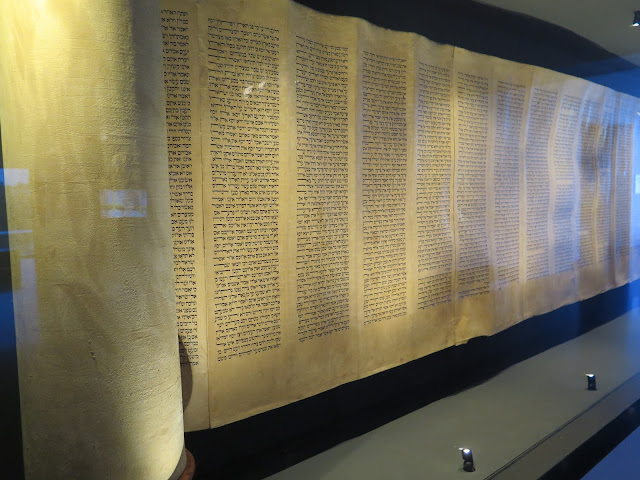The Israel Museum was founded in 1965 as Israel's national museum. It is situated on a hill in Jerusalem near the Israeli Supreme Court and the Hebrew University of Jerusalem. This museum is an absolutely must see if visiting Jerusalem. We were only able to spend only two hours here but it is a place you could spend an day or afternoon.
Before you enter the museum you see a number of art sculptures and this one of an apple was interesting. I stood beside it to give you perception of the size.
Outside the museum we stopped to look at this recreated model of Jerusalem in 66CE. In that year, the Great Revolt against the Romans erupted, resulting in the destruction of the city and the temple. The ancient city was then at its largest, covering an area of 445 acres, more than twice the size of the Old City today. The model reflects ancient Jerusalem at its peak, just before all was lost.
The model is on a scale of 1:50. Each little block was hand cut from Israeli limestone.
The model was built by Hans Kroch, owner of the Holy Land Hotel in memory of his son, Jacob, who died in Israel’s War of Independence. This was produced under the direction of Prof. Michale AviYonah of the Hebrew University of Jerusalem and took four years to complete. In 1966, the model opened to the public at the the hotel and quickly became a popular attraction. In 2006, it was relocated to the Israel Museum.
We went inside the museum which was a display of Egyptian artifacts. This museum ranks among the world's leading art and archaelogy museums that houses 500,000 objects, including the Dead Sea Scrolls.
Photo: Egyptian pottery.
Photo: Egyptian anchor. Interesting and certainly an easier way to make an anchor.
Gold, which the Egyptians regarded as the flesh of the Gods, was valued by the Egyptians because it was everlasting or eternal. Egyptian gold jewelry found in Canaan sheds light on commerce and the exchange of gifts between Egypt and Canaan, whereas gold jewelry produced in the local style attest to the use of Egyptian gold by Canaanite smiths.
Photo: Gold earrings.
I loved the necklaces!
Photo: This clay tablet measured only about 1-1/2". The scribes must have formed the inscriptions in the clay while it was still soft. It's pretty amazing to think that entries of events were recorded on such small plates.
Photo: Tablets no more than 1" in size! It's hard to imagine scribes writing on such tiny tablets! They must have had very good eyesight or very strong magnifying glasses!
Photo: Chair in synagogue.
Photo: This was the robe of a rabbi. This is the other synagogue in the museum. It was smaller but really beautiful!

Photo: Chris Heiner.
Palm trees and olive branches are the most distinctive motivs found in the shapes of the finials as the decoration on Torah cases.
The silver Torah case is richly engraved with vegetal and floral motifs and was an expression of Iraqi influence. Torah cases were produced in large numbers in Jerusalem.










































Did you notice that the synagogue you pictured after the elegant robe had a floor made of sand? It comes from a tropical island somewhere, can't remember where. The museum of Jewish family life was a favorite of mine, also the fine art. Be sure and ask someone to show you the micro mosaics in the fine art section.
ReplyDeleteAmazing detail.
ReplyDelete